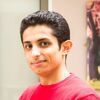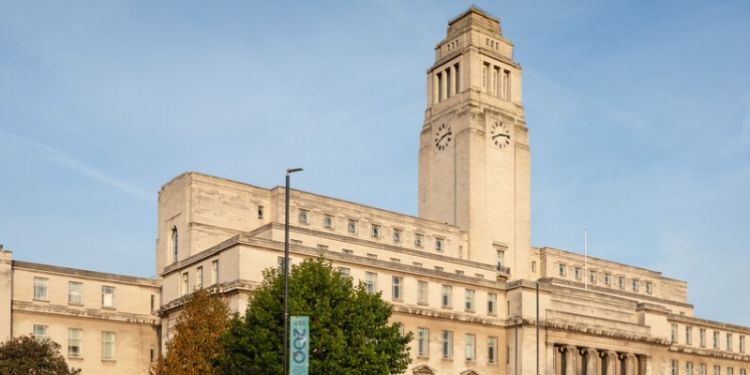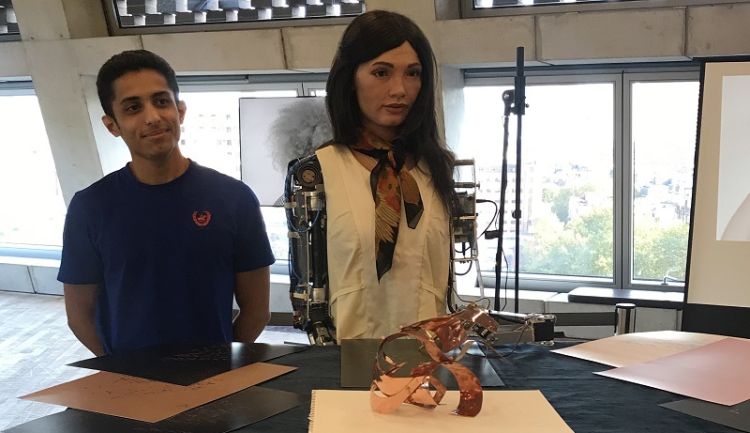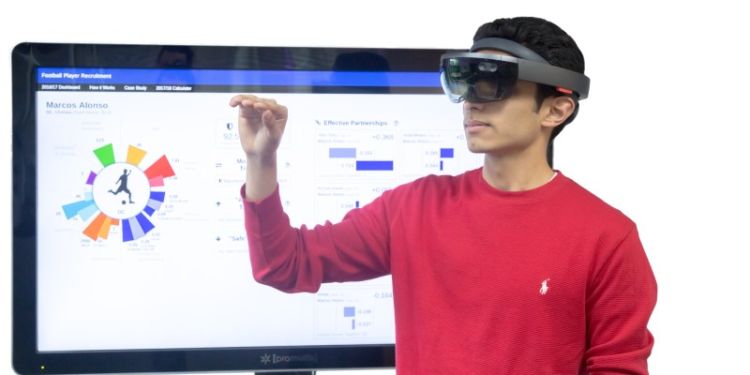
Ziad Abass
- Course: Mechatronics and Robotics MEng (Industrial)
- LinkedIn: https://www.linkedin.com/in/ziad-abass/
Ziad is a student studying an undergraduate degree in Mechatronics and Robotics. Along with his fellow classmate Salah Al Abd, both Ziad and Salah designed Ai-Da’s drawing arm and developed the AI algorithem used by the world’s first ultra-realistic humanoid AI robot artist. During his third year, Ziad undertook a placement year at IBM, working as a DevOps Software Engineer.
Undergraduate life at Leeds
After doing some research and asking friends, Ziad found that the University of Leeds stood out amonst the rest, as he saw the University as the perfect setting for him, a place that creates an optimum balance between the academic and the social aspects of the university experience.

“The future of almost every industry involves robotics, mechatronics or machine intelligence. I chose to study Mechatronics and Robotics at Leeds because the course not only manages to integrate mechanical systems with electrical systems, but also digs deep into computer science fundamentals which mechatronic systems would be useless without. Furthermore, I have always been interested in understanding how intricate machines and softwares function and I felt that this course would help me develop this understanding and prepare me to be an innovator of my own.”
I chose to study Mechatronics and Robotics at Leeds because the course not only manages to integrate mechanical systems with electrical systems, but also digs deep into computer science fundamentals which mechatronic systems would be useless without.
Hands-on learning
“One of the best aspect of the course has been the opportunity to work on projects. Project work are given from as early as year one, which, for me, was crucial to develop a deep understanding of what was being taught in lectures. For example, as a team of 6, we designed and programmed an autonomous mechatronic arm using SolidWorks and built it from scratch. The objective was to create a proof of concept for an arm that can guide a micro robot inside the body from the outside, making colonoscopy procedures non-invasive and much easier and accurate. Our team achieved third place in the competition.
More recently, I worked on developing an interface system based on neuromuscular signals from hand/ forearm gestures to be employed in stroke rehabilitation. I developed a wearable sleeve that can capture muscle signals from the forearm through dry, 3D-printed electrodes and interpret them. Machine learning was then employed to train a classifier that can realise which hand gesture has been performed based on the muscle signals read.
Project work are given from as early as year one, which, for me, was crucial to develop a deep understanding of what was being taught in lectures.
I also enjoyed the lack of monotony in the structure of the course. In terms of teaching, it focuses on only the most practical modules from each of the three involved schools (Electronic and Electrical Engineering, Mechanical Engineering and Computing), therefore helping one focus on what really matters. In terms of assessment, the methods varied greatly from module to module, and this minimised the tediousness of simply sitting countless tests and exams.”
Working on Ai-Da
Named after scientist Ada Lovelace, Ai-Da, the world’s first ultra-realistic humanoid AI robot artist was invented by gallery director Aidan Meller. As an artist, Ai-Da draws, sculpts and creates collaborative paintings with human.
Along with his fellow classmate Salah Al Abd, Ziad and Salah designed Ai-Da’s drawing arm and developed the AI algorithms used by Ai-Da to create human drawing style inspired by 20th century masters including Pablo Picasso and German painter Max Beckmann.
The fact that we were implementing our skillset from university into such a big, relevant project taught us a lot about how the real world works and how to professionally deal with situations beyond the lecture theatre. This made us readier than ever to think even bigger and become part of more amazing projects in the future.

Ziad said, “We implemented smart algorithms that use computer vision to analyse who Ai-Da sees, then developed a control system that produces a path for her arm to follow, based on her interpretation. We then worked alongside Engineered Arts (the company that built the rest of Ai-Da) to integrate our system with their existing one. We created a critical part of a robot that is the first of its kind. People and news agencies around the world were thrilled to find out about Ai-Da who blurs the line between AI and creativity. The artwork created by her is made to promote discussion about the technological revolution we are in as well as the possible futures of AI.
The fact that we were implementing our skillset from university into such a big, relevant project taught us a lot about how the real world works and how to professionally deal with situations beyond the lecture theatre. This made us readier than ever to think even bigger and become part of more amazing projects in the future.”
Industrial placement year
An industrial placement year gives you the opportunity to develop your skills and gain a real insight into working life in the sector. During his third year, Ziad undertook a placement year at IBM, working as a DevOps Software Engineer. Ziad said, “IBM produces and sells computer hardware, middleware and software, and provides hosting and consulting services in areas ranging from mainframe computers to nanotechnology. IBM is also a major research organization with a diverse set of products and services in various fields, including Cloud Computing, Cognitive Computing, Data and Analytics, Internet of Things, IT Infrastructure and Mobile and Security.
I am a software engineer in the Event Streams on Cloud team. Event Streams is a fully managed messaging service that is run on IBM Cloud. We are a team of around 22, and we do not have “fixed” roles in the team as we work in an agile, DevOps method. What that means is that each software engineer in the team is either in the ‘Operations’ squad, or the ‘Development’ squad at a given point in time, and we alternate between the two every 4 weeks. For example when in the operations squad, I would be responsible for maintaining the ‘High Availability’ of our cloud service, and when in the development squad, my role is to work on developing and testing new features for our service.

On a typical working day, we would be assigned to work in pairs. We start each day with a scrum (stand-up meeting), in which each pair summarise what they did the previous day, what their plan is for that day, and if they are facing any problems. Such problems can be addressed by the squad lead, or by anyone else in the scrum. Scrums usually take 15 minutes. Our Event Streams team in China are also with us virtually in the scrum to hand-over any outstanding issues (as their workday is ending while ours is just strating). We would then start work – I would join my pair at one of the pairing stations, where we share one laptop, but each one has a monitor, keyboard and mouse. This means that we can take turns to ‘drive’ during each coding session. Working in pairs allows the sharing of knowledge about our complex architecture, and also brings creative value due to having two different perspectives tackling each problem. This phase forms the bulk of the day. If we are in the ‘Operations’ squad, we would be monitoring alerts systems and checking that everything is up and running. If we are in the ‘Development’ squad, we would be coding and developing new features.
If we reach an issue which we feel requires input from more people, we call for a ‘breakout’. This is a discussion between engineers in the squad in which we talk about the issue and hear from others for suggestions. Due to the open-plan office we have, breakout invitations are informal, and anyone who is interested can join in. At the end of the day, we hand-over to the Event Streams team in the US with any outstanding issues so that they can pick up where we have left off.”
Workplace environment

“I really enjoy the truly agile way of working my team has adopted. We have weekly retrospective sessions in which we reflect about the good and bad about anything in the team. We make constant adjustments in the way we work based on these reflections and hence the team is constantly becoming more productive. The agile workflow allows a very high-paced development cycle, meaning that our customers get daily updates with code we were just working on a few days beforehand It is amazing to see your effort take this little time to have an effect. Agile working also involves us getting weekly updates from the team’s Offering Manager, who is charge of the business/ client side of our product. Being aware of how we are doing from that perspective brings great value as we get feedback from clients which we can use to make improvements iteratively. The fact that everyone in the team rotates through the different roles creates a “shared ownership” culture. We thoroughly understand our product, and nobody is “in charge” of a specific part of it. This also means that I become in some way involved in all sub-projects running within my team, which is incredible really.”
I really enjoy the truly agile way of working my team has adopted. We have weekly retrospective sessions in which we reflect about the good and bad about anything in the team. We make constant adjustments in the way we work based on these reflections and hence the team is constantly becoming more productive.
The future
“I aspire to employ the knowledge and experiences gained through education in the real world to become part of big projects that matter. I’m learning so much at Leeds, and I believe the biggest one would be to always have a positive mindset. I have seen how much grit and determination it takes to innovate and to get projects up and running, and although challenging, maintaining such a positive yet practical attitude especially during stressful times is the key to clear thinking and effective problem solving.
I’m learning so much at Leeds, and I believe the biggest one would be to always have a positive mindset.
My time at Leeds has also shown me the importance of going above and beyond the syllabus. Being successful can never start with fulfilling the minimum requirements of a mark scheme, but rather with going the extra mile when working on a project to think of how it can be bigger, better and more useful. The course is a tough ride for sure, but is also very rewarding. It leaves you with a sophisticated understanding of the systems of the world around you and helps prepare you to be part of the next big thing.”
Find out more
Discover more about our Undergraduate degree courses in the School of Electronic and Electrical Engineering.

